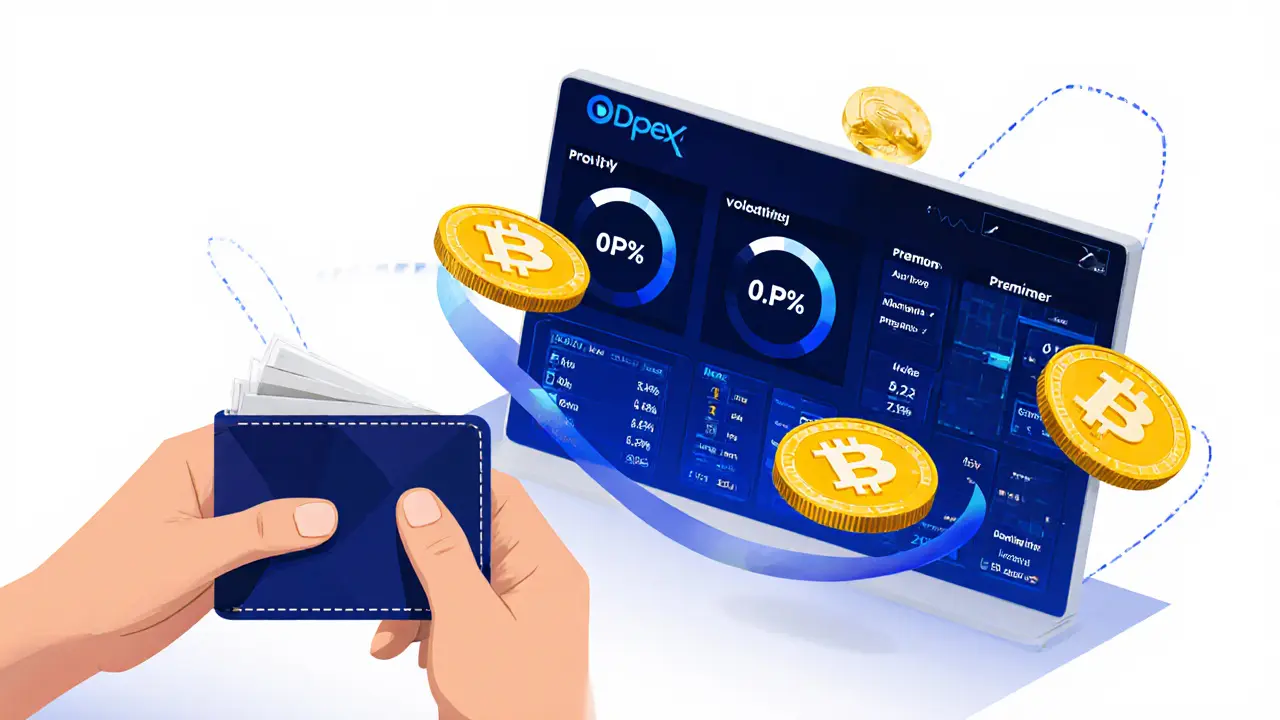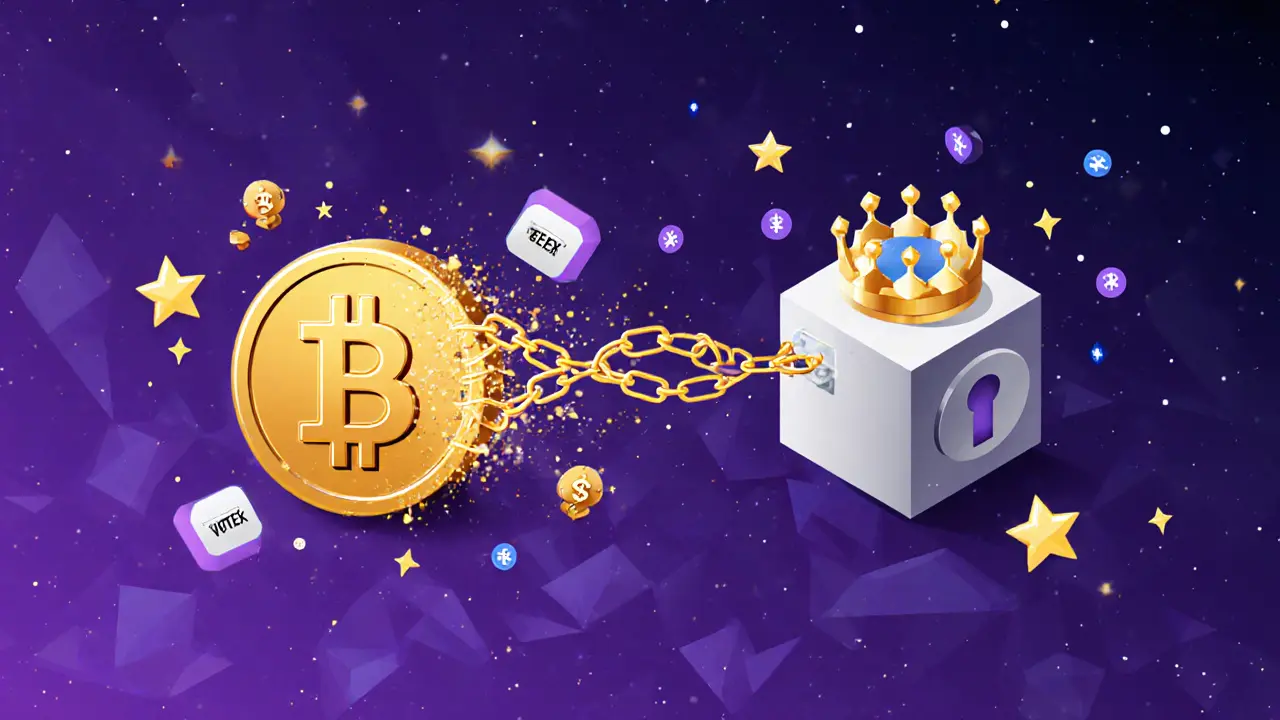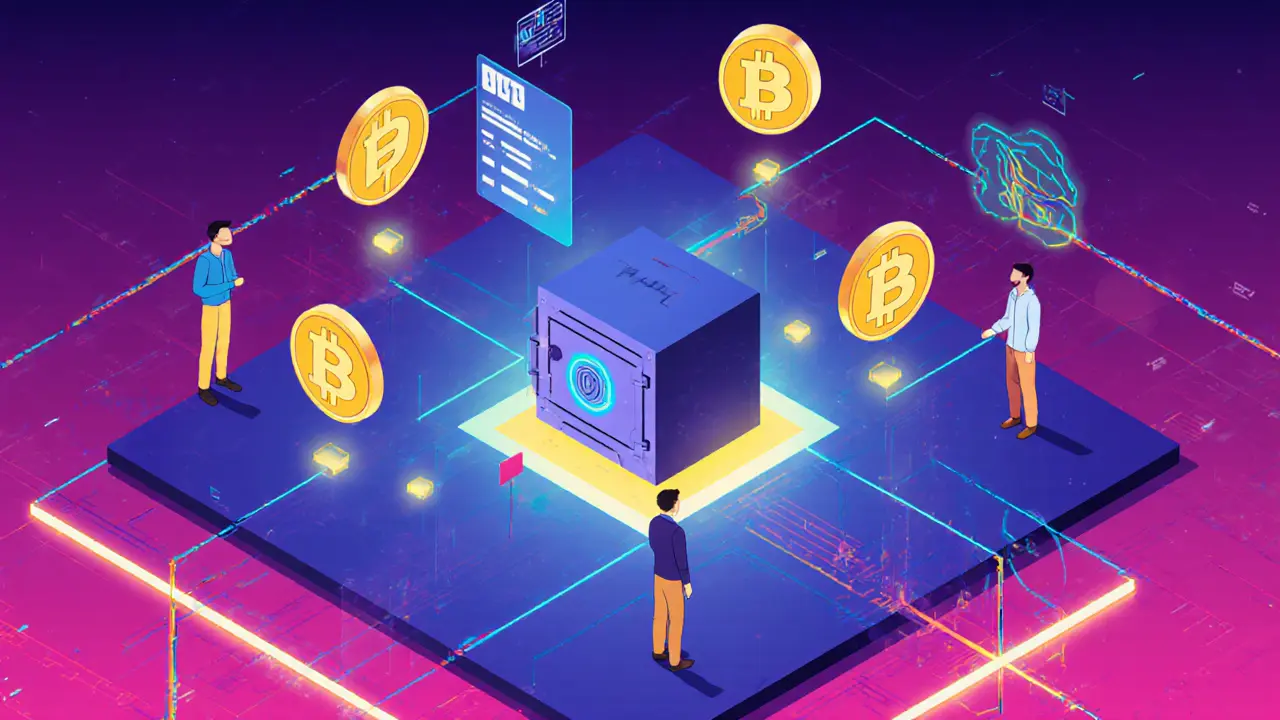DPX Options Yield Calculator
Calculate Your Options Returns
Estimate your potential earnings from selling options on Dopex, including rDPX rebates.
Results
Most crypto coins are built for trading, lending, or staking. But Dopex (DPX) is different. It’s not just another token - it’s a full decentralized options exchange running on Arbitrum. If you’ve ever heard of options trading in stocks and thought it was too complex for crypto, Dopex is trying to change that. It lets everyday users buy and sell options - without a middleman - using simple interfaces and smart contracts.
What Exactly Is Dopex?
Dopex is a DeFi protocol that lets users trade options on cryptocurrencies. Options are financial contracts that give you the right - but not the obligation - to buy or sell an asset at a set price before a certain date. In traditional finance, options are used by hedge funds and institutions to hedge risk or speculate. Dopex brings that same power to retail crypto users.
It runs entirely on Arbitrum, which is an Ethereum Layer 2 solution. That means transactions are faster and cheaper than on Ethereum mainnet. Dopex launched its core product - Single Staking Option Vaults (SSOVs) - in February 2022. These vaults are what make Dopex unique. Instead of locking up huge amounts of capital like other protocols, users can deposit assets into SSOVs and earn yield by selling options. The protocol automatically sets strike prices and expiration dates based on market conditions.
How Does Dopex Work?
Dopex has two main sides: buyers and sellers. Buyers pay a premium to get the right to buy (call) or sell (put) a crypto asset later. Sellers collect that premium and take on the risk of having to fulfill the contract.
Here’s how it works in practice:
- You connect your MetaMask wallet to Dopex.
- You pick an asset - like ETH or BTC - and choose an expiry date and strike price.
- If you’re a seller, you deposit collateral (like ETH) into a Single Staking Option Vault (SSOV). The vault then offers options to buyers at a price based on current volatility.
- If you’re a buyer, you pay the premium and get a tokenized option that you can sell anytime on Dopex’s liquidity pools.
The big win for sellers? Dopex’s SSOVs reduce your risk. You don’t need to hold 100% of the asset to sell a put option. The protocol uses smart contracts to manage collateral dynamically. And if the option expires worthless, you keep the premium.
The DPX and rDPX Tokens
Dopex uses two tokens: DPX and rDPX. They serve completely different purposes.
DPX is the governance token. It has a fixed supply and gives holders voting rights on protocol upgrades, fee structures, and treasury allocations. DPX also collects fees from all trades, vaults, and wrappers on the platform. Think of it like owning a share of the exchange.
rDPX is the rebate token. It’s given to option sellers as a reward for providing liquidity. Every time you sell an option through an SSOV, you earn rDPX on top of your premium. This rebate system helps offset potential losses if the market moves against you. It’s one of the most effective risk-mitigation tools in DeFi options.
veDPX: The Governance Power-Up
Dopex also uses a ve-staking model, borrowed from Curve Finance. If you lock up your DPX tokens for a period of time (up to four years), you get veDPX. This isn’t just a staking reward - it’s voting power.
veDPX holders get:
- More influence in governance votes
- Higher shares of protocol fees
- Access to exclusive incentives and airdrops
This system encourages long-term commitment. People who believe in Dopex’s future lock their tokens. That reduces sell pressure and gives the protocol more stability.

Why Dopex Stands Out
There are other DeFi options protocols - Lyra, Premia, and Opyn - but Dopex has key advantages:
- Capital efficiency: You don’t need to lock up 100% of your ETH to sell puts. SSOVs optimize collateral usage.
- Liquidity for buyers: You can sell your option token anytime on Dopex’s pools. Other platforms make you wait until expiry.
- Rebate system: rDPX reduces losses for sellers - something no other protocol does as effectively.
- Simple interface: Even if you don’t understand Black-Scholes models, Dopex shows you clear strike prices, volatility levels, and potential payouts.
As of late 2022, Dopex had over $23 million locked in its vaults, making it the third-largest options protocol in DeFi. That’s impressive for a project with an anonymous team and no marketing budget.
Limitations and Risks
Dopex isn’t perfect. Here are the big downsides:
- Only on Arbitrum: You can’t use Dopex on Ethereum, Polygon, or Solana. You need to bridge your assets over, which adds complexity.
- Anonymous team: No public founders or LinkedIn profiles. Some users worry about accountability if something goes wrong.
- Options are complex: Even with a simple UI, selling options carries risk. If ETH crashes 50%, your collateral could be wiped out if you’re short puts.
- Regulatory gray zone: Options are classified as securities in many countries. Dopex doesn’t comply with any regulations - which could be a problem in the future.
Still, for users who understand the risks, Dopex offers one of the most rewarding ways to earn yield in DeFi.
Who Is Dopex For?
Dopex isn’t for beginners who just bought their first Bitcoin. But if you’ve used Uniswap, staked on Aave, or farmed liquidity on Curve - you’re ready.
It’s ideal for:
- ETH holders who want to earn extra yield without selling their coins
- Traders who believe a coin won’t move past a certain price (sell puts)
- Investors who want to buy crypto at a discount (buy puts)
- Yield farmers looking for higher returns than standard liquidity mining
If you’re comfortable with DeFi and understand that crypto prices can swing wildly, Dopex can be a powerful tool. But never invest more than you can afford to lose.

Future Plans
The Dopex team has hinted at expanding into institution-grade products. That means options with longer expiries, larger strike ranges, and integration with stablecoins. They’re also looking at building out a stablecoin ecosystem on Arbitrum - which could make Dopex a key player in DeFi’s next phase.
There’s no official roadmap, but the focus is clear: make options trading accessible, efficient, and profitable for everyday users.
How to Get Started
Here’s how to start using Dopex today:
- Get an Ethereum wallet like MetaMask.
- Buy ETH on a centralized exchange like Coinbase or Kraken.
- Bridge ETH to Arbitrum using the official Arbitrum Bridge or a third-party like Across Protocol.
- Go to app.dopex.io and connect your wallet.
- Choose a vault, select your asset and expiry, then decide if you want to buy or sell options.
Start small. Try selling a single ETH put option with a 30-day expiry. See how the premiums and rebates work before scaling up.
Final Thoughts
Dopex isn’t just another crypto token. It’s a financial innovation that brings institutional-grade options to the average crypto holder. With its rebate system, capital-efficient vaults, and strong governance model, it’s one of the most sophisticated DeFi protocols alive today.
It’s not risk-free. But for those who understand the mechanics, it’s one of the best ways to earn yield in crypto without selling your assets. The fact that it’s still growing despite being anonymous and limited to one chain says a lot.
If you’re looking to move beyond staking and liquidity mining - and want to learn how real financial instruments work in DeFi - Dopex is worth your time.
Is DPX a good investment?
DPX isn’t a traditional investment like Bitcoin. It’s a governance token that gives you voting rights and a share of protocol fees. Its value depends on how much trading volume Dopex generates. If the protocol grows, DPX could appreciate. But if usage drops, the token’s value could fall. Only invest what you can afford to lose.
Can I buy DPX on Coinbase?
No, DPX is not listed on Coinbase or other major centralized exchanges. You can only buy it on decentralized exchanges like Uniswap or SushiSwap on the Arbitrum network. You’ll need to bridge ETH to Arbitrum first, then swap for DPX using a DEX.
What’s the difference between DPX and rDPX?
DPX is the governance token - you use it to vote and earn fees. rDPX is the rebate token - you get it as a reward for selling options. rDPX doesn’t have voting power and isn’t traded on exchanges. It’s meant to reduce your risk as a liquidity provider.
Is Dopex safe?
Dopex has been audited by reputable firms and its smart contracts are open-source. But no DeFi protocol is 100% safe. Smart contract bugs, market crashes, or liquidity shortages can lead to losses. Always start with small amounts and never deposit more than you’re willing to lose.
Why does Dopex only work on Arbitrum?
Dopex chose Arbitrum because it’s fast, cheap, and secure - ideal for options trading where timing and low fees matter. Building on multiple chains would split liquidity and make the protocol harder to manage. The team has said they’re focused on making Arbitrum the best place for options, not spreading thin across chains.

Hanna Kruizinga
November 1, 2025 AT 06:29This whole thing feels like a pyramid scheme dressed up as finance. They say 'capital efficiency' but really they're just convincing people to gamble with their ETH while pretending it's investing. And don't even get me started on the anonymous team - if this was a stock, the SEC would shut it down in a week.
David James
November 2, 2025 AT 12:32im not a pro but i think dopex is kinda cool? like i tried selling a put on eth and got paid just for sitting there. i lost a lil when the price dropped but the rDPX helped cover it. maybe its not perfect but its better than just staking lol
Shaunn Graves
November 2, 2025 AT 14:37Who’s auditing the audits? You say it’s ‘open-source’ but that doesn’t mean it’s secure - just visible. And ‘capital efficiency’? That’s just crypto-speak for ‘we’re leveraging your collateral to the max while you sleep.’ You think you’re earning yield? You’re just the pawn in someone else’s options game. And don’t even mention the regulatory gray zone - that’s not a feature, it’s a ticking bomb.
Josh Serum
November 3, 2025 AT 19:47Hey, I get that you’re skeptical, but Dopex is actually one of the most thoughtfully designed DeFi protocols out there. The rebate system? Genius. veDPX staking? Brilliant incentive alignment. And yes, the team is anonymous - but so were Satoshi and the early Ethereum devs. Progress doesn’t need a LinkedIn profile. If you’re scared of smart contracts, maybe stick to Coinbase. But if you want real DeFi innovation, this is it.
Vicki Fletcher
November 5, 2025 AT 07:05Wait, so… rDPX isn’t tradable? That’s… kind of weird? Like, why give people a token they can’t sell or use elsewhere? And why only Arbitrum? Why not Polygon? Or zkSync? It feels… limiting. Like they’re forcing everyone into one lane. Also, I think I misspelled ‘Arbitrum’ - oops! But seriously, this feels like a walled garden with glitter on it.
Nadiya Edwards
November 6, 2025 AT 02:05They’re not building finance - they’re building a tool for the elite to strip wealth from the naive. This is how the system works: make something look complex and technical so regular people feel dumb for not understanding it. Then you charge them premiums, take their collateral, and call it ‘yield.’ And now they want to expand into ‘institution-grade’ products? That’s code for ‘we’re coming for your retirement fund next.’
Ron Cassel
November 7, 2025 AT 08:05Anonymous team? No regulation? Only on Arbitrum? This is exactly why crypto is doomed. You’re trusting code written by ghosts with your life savings. And you call this innovation? This is just financial terrorism with a whitepaper. The fact that people are falling for this proves we’re living in a simulation where everyone’s an idiot.
Malinda Black
November 8, 2025 AT 21:30For anyone new to options in DeFi - start small. Like, really small. Try selling one ETH put with a 7-day expiry and see how the premium and rDPX add up. Don’t go all-in. Read the docs. Watch a couple YouTube explainers. Dopex isn’t magic, but it’s not a scam either - it’s just advanced. And if you’re not ready for advanced, that’s okay. You don’t have to jump in. Just learn first.
ISAH Isah
November 9, 2025 AT 04:28It is indeed a fascinating paradigm shift in decentralized financial architecture. The capital efficiency mechanisms employed by Single Staking Option Vaults represent a non trivial optimization over traditional collateralized lending models. However, the absence of multi chain deployment constitutes a significant systemic vulnerability. Furthermore, the governance model centered upon veDPX may inadvertently entrench power among early adopters thus contradicting the foundational ethos of decentralization. One must also consider the geopolitical implications of relying exclusively on Arbitrum which is under the jurisdiction of a single legal entity
Chris Strife
November 9, 2025 AT 11:27Dopex is a scam wrapped in a whitepaper. Only Americans fall for this stuff. Real finance has regulators, auditors, and accountability. This is just digital gambling with fancy terms. And don’t tell me ‘it’s DeFi’ - that’s just a buzzword for ‘we don’t care if you lose.’ I’m glad I didn’t waste my time. Stick to Bitcoin. At least that’s honest.